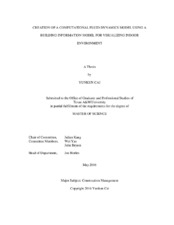Creation of a Computational Fluid Dynamics Model Using a Building Information Model for Visualizing Indoor Environment
Abstract
A building’s indoor environment has a significant impact on people’s work efficiency and quality of life. The amount of energy consumed to control the indoor environment comprises a large portion of maintenance costs. Understanding how efficiently we can control the indoor environment, therefore, has been one of the critical issues in building design. Computational Fluid Dynamics (CFD) is one of the techniques that industry professionals use to understand fluid flow, heat transfer, and indoor chemicals movement, which eventually enables them to analyze indoor environmental conditions.
However, the complex process of CFD data modeling and the time-consuming CFD simulation process have been hindering construction practitioners from using this technique. As a data-rich geometric model, Building Information Modeling (BIM) may provide them with an alternative solution to create a CFD data model.
This study tests if it is possible to produce a CFD model using BIM. It also examines any challenges one may need to deal with in the process of creating the CFD model. For this test, a CFD model of Francis Hall, one of the old buildings on the Texas A&M University campus in College Station, was created using the Building Information Model that the general contractor used for building renovation. This research work also presents problems and barriers experienced in the course of the BIM-based CFD modeling process. The significance of this study is that it (1) verified the feasibility of recycling the Building Information Model and expanding its application areas and (2) provided information for future software developers to improve the interoperability of CFD software and BIM software.
Subject
CFD BIM Indoor EnvironmentCitation
Cai, Yunkun (2016). Creation of a Computational Fluid Dynamics Model Using a Building Information Model for Visualizing Indoor Environment. Master's thesis, Texas A & M University. Available electronically from https : / /hdl .handle .net /1969 .1 /157145.


